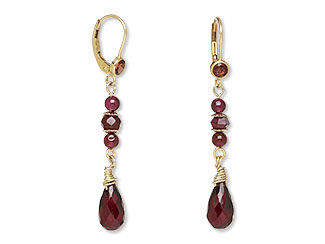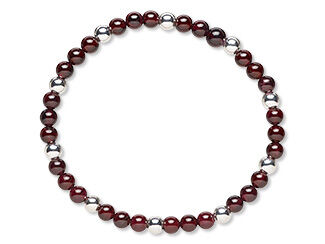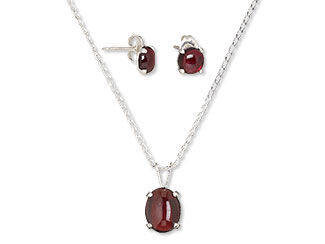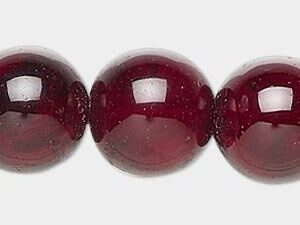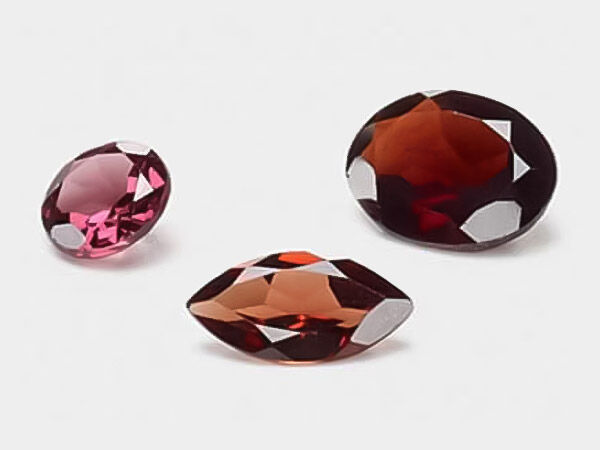Garnet Meaning and Properties
Garnet History
The deep, glossy red color of garnet resembles the juicy seeds of a pomegranate, which is perhaps why its name is derived from the Latin word granatum (meaning “pomegranate seed”). In Greek mythology, a pomegranate was often given as a gift of passion and associated with eternal love. In ancient history, travelers wore garnet gemstones because they were believed to light up the night and provide protection from nightmares and accidents.
Garnets were used in burial jewelry and carved signet rings to proclaim royalty during the Bronze Age (300 BC). Garnets were one of the most popular gemstones of the Vikings and Anglo-Saxons, as revealed in the stunning jewelry and sword fittings in the Staffordshire Hoard, because they believed the blood-red stone improved their fighting prowess.
In the middle ages, one of the garnet properties was commonly believed to be protection from poison. Royals would often drop a garnet gemstone into a glass of wine to ensure the drink was safe. Garnets were also worn by the crusaders as an aid to safely find their way home. Eastern European folktales speak of garnets being worn around the neck to guard against night-wandering vampires. And in Victorian times, the gem was used in engagement rings and other women's jewelry, to mark fidelity in love.
Non gem-grade garnets are frequently used in sandpaper and other grinding and polishing materials.
It's easy to fall in love with the beautiful crimson shade, but garnet also comes in other colors. Watch this video to learn more about this gemstone.

What are the Metaphysical Properties of Garnet?
Garnet symbolizes a quick return to a separated love, fertility and feminine life force.
Legend states that Hades gifted a pomegranate to Persephone before she left his domain to ensure a speedy and safe return. When she did return, the fruit transformed into a handful of the red gemstones.
A garnet stone is often gifted to a loved one before they embark on travel. One of the most commonly believed garnet properties is that the stones aid in the healing of broken bonds of love. Garnets are also known to aid in the treatment of melancholy and depression by acting as a heart and blood stimulant.
Garnet is thought to be extremely beneficial in the realm of business. The stone can attract people to the wearer, which can help provide personal and business success. It is especially beneficial to people wanting to start home businesses.
What is Garnet Made From?
Garnet is a name used to describe a diverse group of silicate minerals that include almandine, pyrope, spessartine, grossular, andradite, Mozambique and uvarovite. The deep wine-red color of almandine garnet results from iron and chromium; the name "garnet" tends to apply to this variety. However, garnets are found in other colors, some of which have their own Gem Note entries:
- Color Change Blue Garnet (blue, blue-green in cool light, red in warm light)
- Demantoid (olive green to emerald green)
- Grossular (yellow)
- Hessonite (orange to orange-brown)
- Leuco-garnet (colorless)
- Melanite (extremely dark red to black)
- Pyrope (pale pink to medium red)
- Rhodolite (pale red to purplish)
- Spessartite (orange to orange-red)
- Topazolite (yellow)
- Tsavorite (green to emerald green)
- Uvavorite (green)
Garnets can display different colors in different types of light and occasionally will showcase faint four-rayed asterism.
Garnets are found in metamorphic and igneous rocks. They form under extremely high temperatures and pressure. Garnet deposits are found in Africa, India, Russia, South America, Madagascar, Pakistan and the United States.
- Mineral Information: Aluminum/Silicate
- Chemical Composition: Mg3Al2(SiO4)3)
- Color: Deep red to bright violet-red
- Hardness: 7 to 7-1/2 (Mohs)
- Specific Gravity: 3.65 - 3.80
- Refractive Index: 1.730 - 1.760
How Do You Clean Garnet?
Clean garnet stones with warm soapy water and a soft brush. Rinse the stone well after washing it. Ultrasonic treatments may be used for most garnets, except the demantoid variety. Steam cleaning garnets may cause color changes from the heat.
Protect garnet from sharp blows, extreme temperature changes and harsh chemicals.
What Chakra Is Garnet?
Red garnet is associated with the root chakra, encouraging a free flow of energy up and down the spine and bringing balance to the body wherever it is needed. In these traditions, chakras are believed to be spinning energy centers within the body that influence emotional, physical and spiritual well-being. Each chakra corresponds to a specific area and color—garnet’s rich red resonates with the root chakra, thought to impart a sense of security and groundedness.
Root Chakra (Muladhara) - Red
- Location: base of spine in the coccyx or tailbone area
- Represents: foundation of self; grounding energy; survival instincts; physical needs (including financial stability); food
- Emotional issues: safety
- Spiritual issues: security
- Physical issues: associated with reproductive system; adrenal system; food or satiety
- Gemstones: bloodstone, garnet, obsidian, smoky quartz
Wearing chakra bracelets featuring garnet can support self-assurance and safety. To dive deeper into gemstone and chakra connections, check out this guide: Chakras and Their Gemstones.
Garnet FAQ
Q: What colors can garnet come in besides red?
A: Garnet can be colorless, but is usually available in a range of colors and hues, including: pink, dark red to black, purplish red, orange-red, orange, orange-brown, yellow, green, olive green, emerald green and blue.
Q: What is the world's rarest garnet?
A: The color changing blue garnet is the rarest (and most expensive). The color is caused by the presence of vanadium or chromium in the gemstone’s structure. Only three deposits have ever been discovered, one on Madagascar, one in Tanzania and the third on the border between Tanzania and Kenya.
Q: What is garnet's significance as a birthstone?
A: Garnet is believed to signify protection, friendship, trust, commitment and love. Garnet is also said to keep the wearer safe during travel.
Q: What did garnet signify as a social status in medieval times?
A: During the middle ages, garnet was used as a cure for bubonic plague (aka the “Black Death”) and was worn by royalty for protection. It was viewed by the medieval church as a symbol of the blood of Christ and an emblem of sacrifice.
Q: Can I use garnet beads in a rosary?
A: Yes. With the tradition of red garnets being viewed as symbols of Christ’s blood, garnet is a popular material for rosaries—particularly rosaries focused on sorrows of Jesus’ mother, Mary.
Designing with Garnet
Garnet is the official birthstone of January. The rich red version of this gemstone mixes well with gold-colored metals and the soft pink colors of pink sea “opal” glass beads, pink opal gemstone beads and rose quartz gemstone beads. Red garnets look attractive with either silver or gold.
A Few Design Inspirations to Get You Started
In this video, learn how to make these stunning earrings using hand-cut garnet gemstones and 14Kt gold-filled findings.

Shop for Garnet
**Please note that all metaphysical or healing properties listed are collected from various sources. This information is offered as a service and not meant to treat medical conditions. Fire Mountain Gems and Beads® does not guarantee the validity of any of these statements.
How did you like this resource? Your feedback helps us provide resources that matter to you most.
Copyright Permissions
All works of authorship (articles, videos, tutorials and other creative works) are from the Fire Mountain Gems and Beads® Collection, and permission to copy is granted for non-commercial educational purposes only. All other reproduction requires written permission. For more information, please email copyrightpermission@firemtn.com.

